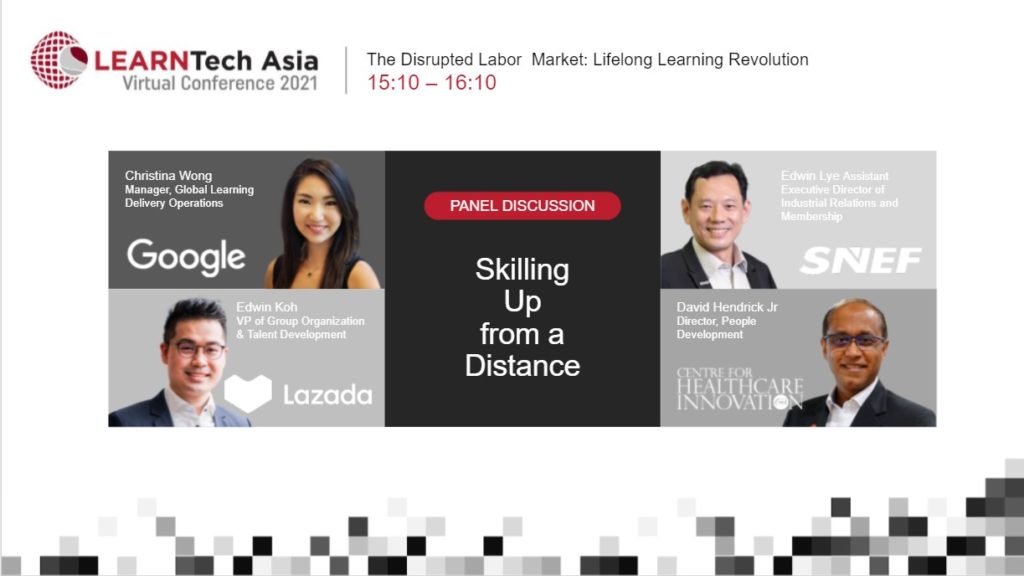“The technology will and has arrived faster than L&D practitioners can train people to be skilled enough to handle the technology,” shared Thomas Paris, Chief Learning Architect of Kydon Group and ZilLearn during the “Digital Learning: Driving the Future of Work” panel discussion at the recent LEARNTech Asia Conference 2021.
A common concern of people is that the rapid advances in technology may see machines outperform its human counterparts. Thus, leaving many humans jobless.
Indeed, the World Economic Forum reported that by 2025, approximately 85 million jobs may be displaced due to the shift in the division of labor between machines and humans. Additionally, the digitalization and automation of labor allows for a more low-touch future which is much needed during the COVID-19 pandemic.
Consequently, this has left many rightfully worried about their jobs and careers. While some have jumped at the opportunity to skill up to remain competitive and flexible within their industries or successfully pivot between industries, others have not been as fortunate.
Learning is not always accessible to everyone
When learning, skilling, and training initially migrated to the virtual realm, many assumed that the pandemic made learning easily accessible to everyone. However, that has not been the case for all.
With more than 13,000 islands, Indonesia is a prime example of how inaccessible digital learning is without a digital infrastructure that is both inclusive and accessible.
“Inclusivity is only possible when digital learning is created a for a diverse population in multiple languages,” said Adrianus Yoza Aprilio, Founding Member of the ASEAN Future Workforce Council. “Inclusivity and accessibility should also include the availability of digital infrastructure to allow for easy access to the digital world.”
Besides that, many have reported a dramatic increase in traffic across emails and video conferencing platforms which have left them with little to no time to complete their daily work tasks, let alone skill up during their working hours.
In a survey conducted by Microsoft, one in five respondents said that their employer “doesn’t care about their work-life balance” while 54 percent reported that they felt overworked and 39 percent said that they are exhausted.
Moreover, people with children or elderly in the household face additional challenges in balancing work, skilling up, and household responsibilities.
Be it the lack of digital infrastructure, poor work-life balance, and/or a lack of diversity and inclusivity in the digital learning environment, the pandemic has certainly not made learning easily accessible to all.
Lead by learning
As 2022 approaches, it is necessary for leaders to prioritize the empowerment of their people through learning and development.
If there is anything employers ought to have learned in the past two years is that their employees ought to be their number one priority.
However, “before encouraging leaders to create a better learning environment for their employees, we need to educate leaders on the need to pivot learning,” said our panel of experts during a separate session focused on “Skilling up from a distance.”
This panel included Christina Wong, Manager of Global Learning Delivery Operations at Google; David Hendrick Jr, Director of People Development for the Centre for Healthcare Innovation at Tan Tock Seng Hospital; Edwin Koh, Vice President of Group Organization & Talent Development at Lazada; and Edwin Lye, Assistant Executive Director of Industrial Relations and Membership at Singapore National Employers Federation.

They highlighted that it is equally important for leaders to be educated especially within the Asian region as the more conservative leaders may fear that if they encourage their employees to improve their skills, they will leave the company whenever an opportunity arises.
Although that may be the case, leaders who choose to not invest in their people’s learning journey will be left with a workforce who is irrelevant and incapable of adapting to the disrupted labor market.
Learning online is not the same as learning in-person
A common issue raised by the attendees during the Conference is that the online learning courses introduced by their employers are somewhat shallow and too lengthy.
Thus, leaving many to perceive that learning and development is an unnecessary and burdensome task.
“The reason for this is that people misconstrue digital learning for merely uploading all the elements of an in-person training course to a digital platform,” said Aprilio.
This is why L&D and HR experts have to educate both employers and employees on the importance of microlearning.
In short, microlearning is learning in small chunks with the aim of delivering a specific learning objective. These bite-size learning sessions can be in the form of a game on a mobile device or a short video. Either way, microlearning has proven to be more effective in engaging learners.
That said, people are also concerned about the validity of the content and quality of virtual learning certificates.
“We need to figure out how we can ensure that virtual learning certificates are on par with physical learning certificates,” said Nazral Safril Mohammad Sapari, Director of Human Capital for Malaysia Digital Economy Corporation (MDEC). “How we measure attendance and participation in the virtual realm will and must be different from the physical realm. So we need to address these differences.”
Moving forward, reskilling and upskilling from a distance or in hybrid mode will only be effective if it is learner-centric.
Not only must the learning roadmap align the learner’s wants with the organization’s demands, it must be flexible and inclusive to cater to the diverse demographic and needs of the workforce.
Above it all, the desire to learn must come from the individuals themselves.
If you missed the conference and would like to tune in to these panel discussions or other sessions, register for the premium pass here.




